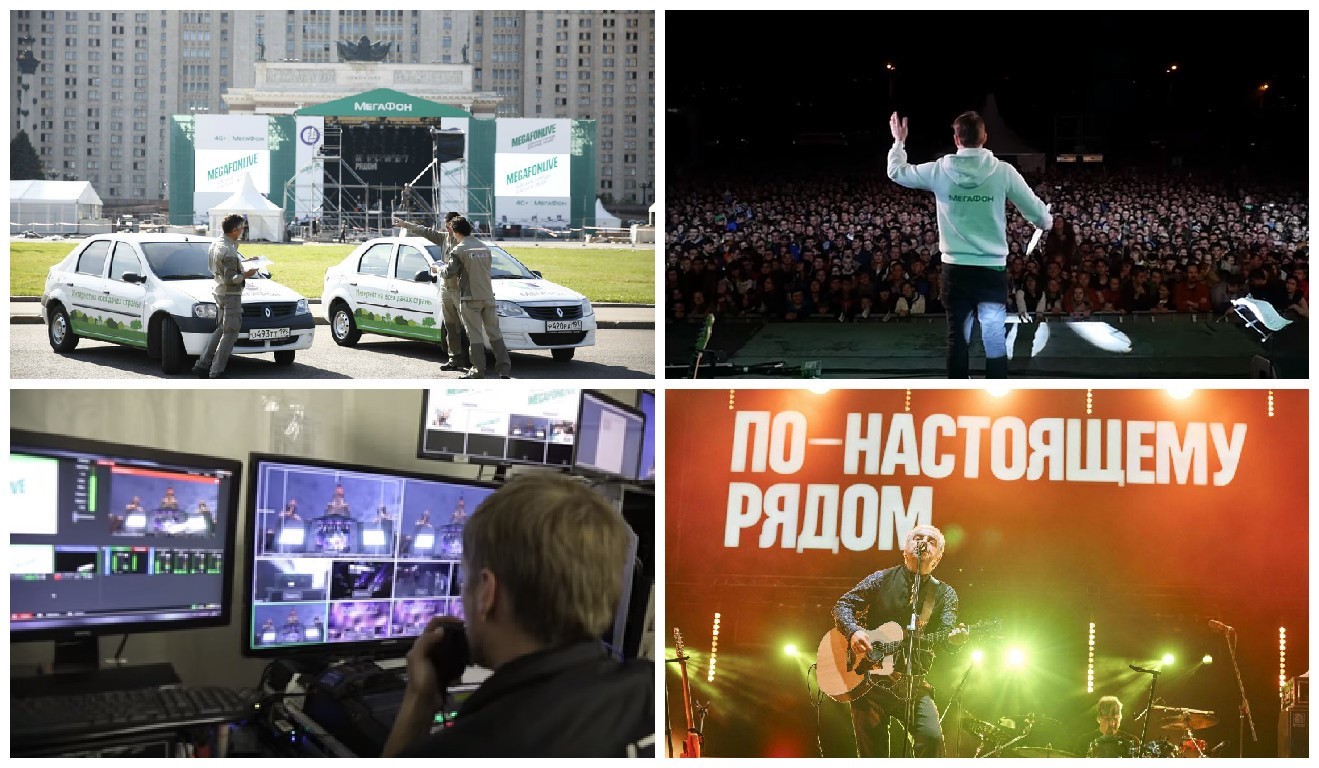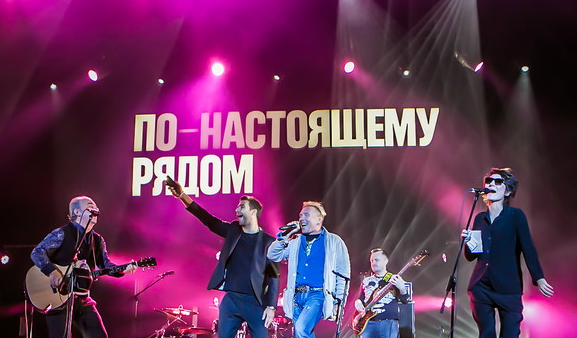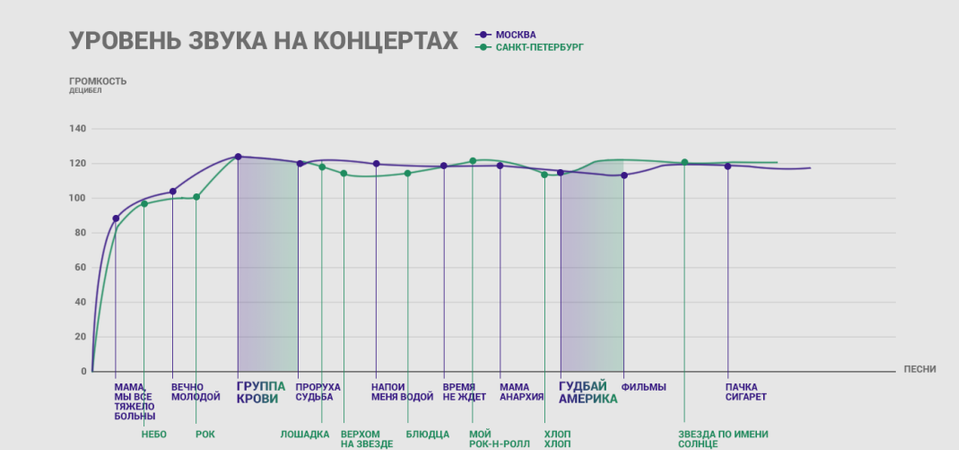As we did the music festival "MegaFonLive"
Among Habr's readers there are many music lovers, and therefore we want to tell you about the experience of organizing (its technical part) the unique music festival “MegaFonLive” “Close cities. Close People ”, which took place in August-September of this year in ten cities with a population of over 1 million people in Russia. The event was held in support of the new positioning of the company "really close." With this project we wanted to show that each of us has a lot more truly close people than we think and clearly demonstrate how cellular communication helps bring together not only individuals, but also entire cities.
In this post, the organizing team told about the preparation and holding of the festival, and Andrey Basikov, head of the federal center for the implementation of MegaFon projects, about how the technical implementation of the project was arranged.

Prehistory As everyone remembers, for a long time, the main slogan of MegaFon was the phrase “The future depends on you.” This year, we changed the global positioning strategy to “really close”. Why did we choose such positioning? The task of modern technology is to bring people together and constantly maintain their emotional connection with loved ones: write, call, send a photo or show a video.
')
On the basis of the new brand platform, a series of concerts “Close Cities. Close people ”, revealing the essence of the new key idea. We liked the format of the music festival, because it is massive, and we, like our subscribers, love high-quality music. Just as the MegaFon connection connects people all over Russia, so the MegaFonLive concerts bring people together from different cities.
The main feature of the project is the idea of the final song: its one-time performance by two artists, two cities. Yes, it was possible to make the usual series of concerts in different cities, but all this already happened. But it was important for us to bring our new positioning, and therefore we liked the idea to unite cities, to unite people. When you are at a concert in St. Petersburg, and your friend is in Moscow (or vice versa), you get incredible emotions, a feeling that you are there, you are together right now, even being in different cities. Thanks to the live broadcast, you can see each other and interact with each other: even send your own selfie-hi to the screen next to the stage. The culmination of the project is when one song is simultaneously sung, for example, “Tea” and Garik Sukachev in different cities!
The difficulty in organizing such a project was to establish a one-time uninterrupted, stable inclusion and parallel performance of one song between two cities and two musical groups, respectively. To participate in the event, we gathered the most famous Russian rock musicians (among them Zemfira, Splin, Chayf, Vyacheslav Butusov, Semantic Hallucinations, Garik Sukachev, Olga Kormukhina, Chicherina and the band Zveri). Each of them has very high requirements not only for sound quality, but also for the quality of the show. It was not easy to persuade them to experiment, with each one they had to separately choose a song, rehearse the order of their performances, both before the start of the project, and during the sound check. Yuri Dontsov, the concert director of the project, worked with musicians, the repertoire, including organizing rehearsals. The result was very impressive.

What does the standard technology of tele-bridge organization look like during a music festival? A signal is sent from one city to another, is received, and then is sent back in turn. And such that the signal worked on both sides at the same time was not yet.
So, for example, on July 13, 1985 in two different parts of the world - London and Philadelphia - the charity festival "Live Aid", organized by Bob Geldof to collect funds for the starving Africa, was held. In those years, there were many problems with transatlantic television and technology. So during the performance of the song “My Generation” by the “Who” group, immediately after Roger Doltri sang “Why don't you all fade ...”, the generator exploded.
At the end of the festival, artists Mick Jager and David Bowie were supposed to sing together, being in different cities - London and Philadelphia. But to realize this bold idea failed because of the imperfection of the technologies of the time.
After 30 years, we decided to repeat this large-scale technical experiment. And we did it - not only because the technologies evolved, but also because our technical specialists did a great job.
In fact, channel organization is a fairly standard task. Our main problem was in the tight deadlines: in some cities, the sites where we had to mount the equipment were determined a few days before the event. We completed the construction of the site, that is, the cable and the corresponding infrastructure, directly in the control room, where the producer's group of events was located.
We had to not only organize and test the channel, but also pass it on to the director's group so that they could test it on live equipment, evaluate how the picture will look from the side, whether it corresponds to the quality parameters that were presented to the channels.
Sound engineers, directors of the broadcast and technical specialists worked in the control room:

Initially, we, as planned, organized them with geographically separated reservations. That is, channels, for example, from Nizhny Novgorod to Kazan, were physically spaced throughout the entire route, which excluded the degradation of the service in the event of a single cliff. At one of these events, we had an emergency situation when one route failed, but, nevertheless, due to the fact that technical solutions were developed and implemented correctly, for the end users (viewers of “MegaFonLive”) the incident passed unnoticed .
Our area of responsibility was the organization of the L2VPN channel between cities for video broadcasting. To do this, we, as already mentioned, made channels with reservations geographically distributed over the network. Plus, an additional service was also organized - an online broadcast on YouTube.
MegaFon and NetByNet were our main partners on cable channels, communication channels and Internet setup networks. For 2-3 weeks we sent the technical layout of the site from the venue of the event, the company analyzed the technical capabilities (cabling, installation of equipment, installation of mobile base stations, etc.) in order for the Internet to work stably and, most importantly, not in one side, and in two, since the event was designed for two cities. Some cities had to undertake significant construction work on the organization of cable infrastructure, and MegaFon was engaged in global communications organization. We were also assisted by NetByNet and Synterra Media.


Pro difficulties. For the technical director of the project, the main difficulty is to understand the sound delay, to make the sound flawless and clear. For the contractor and the company that organized broadcasting on YouTube and teleconference-Internet, the main task was high-quality and fast communication - the Internet had to “fly”, and the channel between cities was as reliable as possible. For a music producer, the main goal is to negotiate with the artists, to convince the artist to sing what we need, to sing the final song, to sing it together with a certain artist.
There were a lot of nuances here: someone needed to prepare arrangements in advance, because the tonality did not coincide. Logistics and logistics company had to find the right number of machines, if necessary, urgently bring the necessary parts and infrastructure elements. The broadcast director (for example, in Moscow we worked with a German director) was tasked with ensuring the broadcast with this artist, responding to his deadlines and vision.
It was all very difficult, but in the end everything worked out for us.

In the finale of the Moscow-Peter concert, all the participants — and this is almost 100,000 people in the northern capital and more than 150,000 people in Moscow — together sang the song “Goodbye America!” By Vyacheslav Butusov. With the sound level meter, we measured the sound: it turned out that this song was played the loudest!
Noise measuring gadget

But the same joint song through the eyes of our viewers in a one-time performance of “Yu-Piter” & “Tea”, Garik and Zemfira - Goodbye, America (“MegaFonLIVE”):
We toured 10 cities in different parts of Russia (Krasnoyarsk and Novosibirsk, Yekaterinburg and Chelyabinsk, Kazan and Nizhny Novgorod, Moscow and St. Petersburg, Samara and Rostov-on-Don), bringing together more than 420,000 guests and about 590,000 spectators who watched video and broadcast on the Internet. This is more than the total population of Cyprus or Montenegro! We filled the Internet: more than 200,000 concert photos were published in various social networks.
Watch our film Backstage MegafonLive on how it was:

We recorded that the maximum load on the network at peak moments of concerts exceeded the usual average 5 times. We worked on the quality of communication, the network survived, and made it possible for hundreds of thousands of people to feel that they were all close, despite the distances, - really close.

Drive tests are a research of a platform directly "on the place". Special measuring equipment assesses the quality of the coating, the maximum and minimum loads that the network can withstand. Based on these data, either upgrades to the current base stations that are located in this area were carried out, or, if this was not enough, additional mobile base stations were installed during the event.
Mobile base station installation in progress

From the point of view of functionality, virtually the entire MegaFon infrastructure was involved: colleagues from the development of the network developed technical solutions; builders who carried out modernization and construction of fiber optic lines (fiber-optic communication lines) to points; employees who were engaged in the optimization of the radio network, carried out measurements and parametric optimization; colleagues from service, who installed, set up equipment, organized and tested channels. Also, the Unified Network Control Center was involved, which provided, among other things, monitoring both the transport network (organized channels) and the radio network for high-quality mobile services. At the time of the event itself, the duty personnel were organized in case of unforeseen problems. In each city of the event, at least 7-10 employees of MegaFon’s infrastructure were involved. In total, 90 technical specialists of Megafon worked on the project.
During the preparation for the festival, our technical specialists carried out all the necessary work so that every spectator of the concert could easily reach their loved ones, share impressions and put vivid photos and videos on social networks.
We once again made sure that for such events a high-quality and reliable connection is as integral as the concert itself. Therefore, all of our work aimed at increasing capacity, organizing reservations, were justified by the result and assessment that we received from the organizers and viewers, both attending the festival "live" and those who watched from the screens of their gadgets.
Thanks to our information partners! The festival “MegaFonLive” was supported by: “Our Radio” , a group of companies “Rambler & Co” , cultural and entertainment portal Geometria.ru . Next year we will repeat!
Have you been to our concerts? Share your impressions!
In this post, the organizing team told about the preparation and holding of the festival, and Andrey Basikov, head of the federal center for the implementation of MegaFon projects, about how the technical implementation of the project was arranged.

New big idea
Prehistory As everyone remembers, for a long time, the main slogan of MegaFon was the phrase “The future depends on you.” This year, we changed the global positioning strategy to “really close”. Why did we choose such positioning? The task of modern technology is to bring people together and constantly maintain their emotional connection with loved ones: write, call, send a photo or show a video.
')
On the basis of the new brand platform, a series of concerts “Close Cities. Close people ”, revealing the essence of the new key idea. We liked the format of the music festival, because it is massive, and we, like our subscribers, love high-quality music. Just as the MegaFon connection connects people all over Russia, so the MegaFonLive concerts bring people together from different cities.
The main feature of the project is the idea of the final song: its one-time performance by two artists, two cities. Yes, it was possible to make the usual series of concerts in different cities, but all this already happened. But it was important for us to bring our new positioning, and therefore we liked the idea to unite cities, to unite people. When you are at a concert in St. Petersburg, and your friend is in Moscow (or vice versa), you get incredible emotions, a feeling that you are there, you are together right now, even being in different cities. Thanks to the live broadcast, you can see each other and interact with each other: even send your own selfie-hi to the screen next to the stage. The culmination of the project is when one song is simultaneously sung, for example, “Tea” and Garik Sukachev in different cities!
The difficulty in organizing such a project was to establish a one-time uninterrupted, stable inclusion and parallel performance of one song between two cities and two musical groups, respectively. To participate in the event, we gathered the most famous Russian rock musicians (among them Zemfira, Splin, Chayf, Vyacheslav Butusov, Semantic Hallucinations, Garik Sukachev, Olga Kormukhina, Chicherina and the band Zveri). Each of them has very high requirements not only for sound quality, but also for the quality of the show. It was not easy to persuade them to experiment, with each one they had to separately choose a song, rehearse the order of their performances, both before the start of the project, and during the sound check. Yuri Dontsov, the concert director of the project, worked with musicians, the repertoire, including organizing rehearsals. The result was very impressive.
Two cities, two songs and two-way Internet

Andrei Basikov, head of the federal center for the implementation of MegaFon projects: From a technical point of view, our main task was to organize a live broadcast between cities. It is important that the broadcast goes with a minimum time delay and is not interrupted.
What does the standard technology of tele-bridge organization look like during a music festival? A signal is sent from one city to another, is received, and then is sent back in turn. And such that the signal worked on both sides at the same time was not yet.
So, for example, on July 13, 1985 in two different parts of the world - London and Philadelphia - the charity festival "Live Aid", organized by Bob Geldof to collect funds for the starving Africa, was held. In those years, there were many problems with transatlantic television and technology. So during the performance of the song “My Generation” by the “Who” group, immediately after Roger Doltri sang “Why don't you all fade ...”, the generator exploded.
At the end of the festival, artists Mick Jager and David Bowie were supposed to sing together, being in different cities - London and Philadelphia. But to realize this bold idea failed because of the imperfection of the technologies of the time.
After 30 years, we decided to repeat this large-scale technical experiment. And we did it - not only because the technologies evolved, but also because our technical specialists did a great job.
Channels for video broadcasting
In fact, channel organization is a fairly standard task. Our main problem was in the tight deadlines: in some cities, the sites where we had to mount the equipment were determined a few days before the event. We completed the construction of the site, that is, the cable and the corresponding infrastructure, directly in the control room, where the producer's group of events was located.
We had to not only organize and test the channel, but also pass it on to the director's group so that they could test it on live equipment, evaluate how the picture will look from the side, whether it corresponds to the quality parameters that were presented to the channels.
Sound engineers, directors of the broadcast and technical specialists worked in the control room:

Initially, we, as planned, organized them with geographically separated reservations. That is, channels, for example, from Nizhny Novgorod to Kazan, were physically spaced throughout the entire route, which excluded the degradation of the service in the event of a single cliff. At one of these events, we had an emergency situation when one route failed, but, nevertheless, due to the fact that technical solutions were developed and implemented correctly, for the end users (viewers of “MegaFonLive”) the incident passed unnoticed .
Our area of responsibility was the organization of the L2VPN channel between cities for video broadcasting. To do this, we, as already mentioned, made channels with reservations geographically distributed over the network. Plus, an additional service was also organized - an online broadcast on YouTube.
MegaFon and NetByNet were our main partners on cable channels, communication channels and Internet setup networks. For 2-3 weeks we sent the technical layout of the site from the venue of the event, the company analyzed the technical capabilities (cabling, installation of equipment, installation of mobile base stations, etc.) in order for the Internet to work stably and, most importantly, not in one side, and in two, since the event was designed for two cities. Some cities had to undertake significant construction work on the organization of cable infrastructure, and MegaFon was engaged in global communications organization. We were also assisted by NetByNet and Synterra Media.
Kilowatts of sound, cable kilometers and rock stars of the first magnitude

Ekaterina Sokolova, Project Manager, MegaFonLive on the Brandnew side:
To build a concert venue, it took 1000 light devices, 600 tons of stage equipment, 20 km of cable, 18 cars of 20 tons each, 1,200 kilowatts of sound.

Pro difficulties. For the technical director of the project, the main difficulty is to understand the sound delay, to make the sound flawless and clear. For the contractor and the company that organized broadcasting on YouTube and teleconference-Internet, the main task was high-quality and fast communication - the Internet had to “fly”, and the channel between cities was as reliable as possible. For a music producer, the main goal is to negotiate with the artists, to convince the artist to sing what we need, to sing the final song, to sing it together with a certain artist.
There were a lot of nuances here: someone needed to prepare arrangements in advance, because the tonality did not coincide. Logistics and logistics company had to find the right number of machines, if necessary, urgently bring the necessary parts and infrastructure elements. The broadcast director (for example, in Moscow we worked with a German director) was tasked with ensuring the broadcast with this artist, responding to his deadlines and vision.
It was all very difficult, but in the end everything worked out for us.
The sound level at the concert

In the finale of the Moscow-Peter concert, all the participants — and this is almost 100,000 people in the northern capital and more than 150,000 people in Moscow — together sang the song “Goodbye America!” By Vyacheslav Butusov. With the sound level meter, we measured the sound: it turned out that this song was played the loudest!
Noise measuring gadget

But the same joint song through the eyes of our viewers in a one-time performance of “Yu-Piter” & “Tea”, Garik and Zemfira - Goodbye, America (“MegaFonLIVE”):
We toured 10 cities in different parts of Russia (Krasnoyarsk and Novosibirsk, Yekaterinburg and Chelyabinsk, Kazan and Nizhny Novgorod, Moscow and St. Petersburg, Samara and Rostov-on-Don), bringing together more than 420,000 guests and about 590,000 spectators who watched video and broadcast on the Internet. This is more than the total population of Cyprus or Montenegro! We filled the Internet: more than 200,000 concert photos were published in various social networks.
Watch our film Backstage MegafonLive on how it was:
How we worked with high network load

Andrey Basikov, head of the MegaFon federal project implementation center:
Since our company is the largest telecom operator, we also had to improve the quality of coverage at the festival sites. This was done by our colleagues directly at the branches, since they know best of all the state of the network in a certain area. The company's specialists from our regional offices conducted drive tests at sites, analyzed the results, developed and applied solutions on the network that allowed the network to work stably during peak loads.
We recorded that the maximum load on the network at peak moments of concerts exceeded the usual average 5 times. We worked on the quality of communication, the network survived, and made it possible for hundreds of thousands of people to feel that they were all close, despite the distances, - really close.

Drive tests are a research of a platform directly "on the place". Special measuring equipment assesses the quality of the coating, the maximum and minimum loads that the network can withstand. Based on these data, either upgrades to the current base stations that are located in this area were carried out, or, if this was not enough, additional mobile base stations were installed during the event.
Mobile base station installation in progress

From the point of view of functionality, virtually the entire MegaFon infrastructure was involved: colleagues from the development of the network developed technical solutions; builders who carried out modernization and construction of fiber optic lines (fiber-optic communication lines) to points; employees who were engaged in the optimization of the radio network, carried out measurements and parametric optimization; colleagues from service, who installed, set up equipment, organized and tested channels. Also, the Unified Network Control Center was involved, which provided, among other things, monitoring both the transport network (organized channels) and the radio network for high-quality mobile services. At the time of the event itself, the duty personnel were organized in case of unforeseen problems. In each city of the event, at least 7-10 employees of MegaFon’s infrastructure were involved. In total, 90 technical specialists of Megafon worked on the project.
findings
During the preparation for the festival, our technical specialists carried out all the necessary work so that every spectator of the concert could easily reach their loved ones, share impressions and put vivid photos and videos on social networks.
We once again made sure that for such events a high-quality and reliable connection is as integral as the concert itself. Therefore, all of our work aimed at increasing capacity, organizing reservations, were justified by the result and assessment that we received from the organizers and viewers, both attending the festival "live" and those who watched from the screens of their gadgets.
Thanks
Thanks to our information partners! The festival “MegaFonLive” was supported by: “Our Radio” , a group of companies “Rambler & Co” , cultural and entertainment portal Geometria.ru . Next year we will repeat!
Have you been to our concerts? Share your impressions!
Source: https://habr.com/ru/post/271161/
All Articles